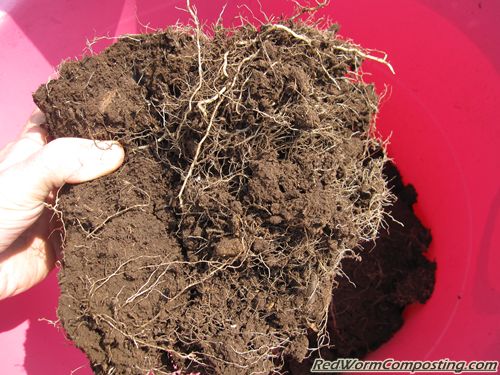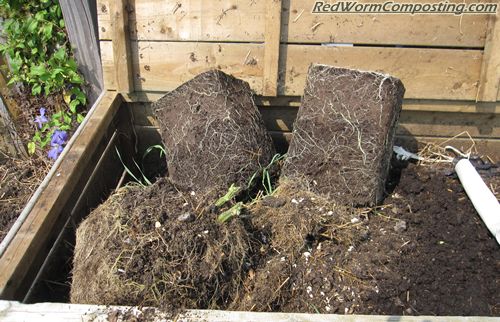Sounds like some sort of wrestling event, doesn’t it?
😆
After a period of foot dragging, followed by some humming and hawing I decided once and for all, today, that I was going to take down all my tomato buckets, along with one of my hanging tomato planters. They’ve all been on the decline for the past few weeks, and the drought-like conditions as of late certainly haven’t been helping. Even though most of them were still limping along and producing tomatoes, they were looking terrible and just generally becoming a hassle.
Sooooo…chop, chop!
Of course, I certainly wasn’t going to take everything down without having a good look down below! I wasn’t overly optimistic that I’d find thriving Red Worm populations, but figured it would be interesting nevertheless.
I started with the hanging container. Given the small volume, and the poor shape the plant was in, I actually expected to see the lowest number of worms. As it turned out, it probably had more worms than most of the buckets – although, still not what I would consider “a lot”.
Interestingly enough, it seemed as though most of the worms in this container were concentrated up in the alpaca manure zone at the top (directly under several small burlap bags), and right in the middle where I had also added some burlap in an effort to separate the “black earth” soil (added down in the bottom) from the vermicompost (up top). This burlap layer seems to have retained moisture quite well, and I think that was definitely the key.

Among all the containers dumped today, there were certainly some consistencies – including some things that help to explain why both plants and worms alike did not do all that well.
For one thing – and there are certainly no surprises here – the tomato roots spread extensively throughout the soil/compost. I don’t think that this alone created major issues for the worms (i.e. I don’t think the roots physically forced the worms out) – I should have a better idea once I clean out my larger box systems – but it is fairly safe to say that all those roots contributed to some very dry conditions in these containers. This was then compounded by the fact that the peat/coir components in the “soil” zones became resistant to re-wetting (ever tried to moisten dry peat moss – can be a royal pain!), which helps to explain why water was pouring so quickly out the bottom of these containers whenever I watered. Also likely helps to explain why I found so few worms in the soil zones.
When it comes down to it, I suspect that my Worm Inn tomato garden is simply holding moisture better than these other systems (as are the bigger wooden box systems) and that’s having a major impact on the success of the plants and the worms.
Once I was finished with my root zone examination, I added the materials to various other worm composting bins (including my big wooden bed, pictured below). I’m sure there is still plenty of food/habitat value left in this stuff, and won’t be surprised to find it crawling with worms once it does start to moisten (hopefully we’ll get some rain before October! lol)






I’m just about ready to do the same Bentley. The plants sure look terrible, but sooooooo many tomatoes yet to harvest. I’m kinda scratching my head as to why though.
I have some wild kind of green bean that showed up.Bird Maybe?
So i pulled them up and decided to give my worms the vines and leaves.i pulled the beans off and was debating cooking them and feeding them to my worms.That’s when i made an awkward discovery.I had them sitting on my flow thru lids for a couple of days.When i was sitting down and checking under my bin,i heard a cracking noise and got hit with peas.I found out this kind,when it dries it breaks open wildly and the shell twists open throwing seeds all over the place.Man i got to get some safety glasses!
I don’t think any one had as good of luck this year with tomatoes.
Must be that El Beanyo blowing in! Or should i say up!
Bentley–do you hum and haw in your region of Canada? In Wisconsin we hem and haw. Just curious!
Your mention of the roots reminded me–I noticed as I was harvesting garlic this year that the worms seemed to really love the root zone of my garlic plants. Every single garlic bulb I pulled (and I planted lots) had at least one worm in it. Some had multiple worms. Any ideas on what’s happening there?
I pulled all my tomatoes this morning. I’m going to do a better job staking next year, too many against the ground that ended up rotting. I threw about half into the compost, but still had enough tomatoes from 9 plants to get 100 tomatoes today, and that’s after I ate a bunch. Then the last of the corn, 22 spaghetti squash from 3 plants!?, huge zucchini and a bunch of cucumbers. Is it safe to put tomato plants in the compost if they have blight on them?
Anna – I pulled a few of the tomatoes roots and all (most I just cut off) and noticed they were full of earthworms! The native ones we have around here. They aren’t nearly as upset at seeing the sun as red wigglers so I got a few pics. I think I ended up finding about 6 or 7 per plant.
I’m not sure about hum, hem, or hawing, but I do go outside and putter in the garden.
PAUL – Scratching your head as to why the tomatoes look terrible?
A lot of my garden tomato plants are coming down with the same disease I got hit with last year. This drought weather, along with my terrible support efforts really haven’t helped. Like yourself, still lots of tomatoes to harvest though – actually did a big harvest today (will write about it soon). Hoping most of the plants hold out and are able to produce a bunch more before I have to chop them down!
———–
LARRY – Never a dull day on your end, eh? LOL
———–
ANNA – In Canada we have plenty unique lingo, but are also influenced a fair bit by both UK (“the Queen’s English”) and USA (good ol’ Hollywood mostly to blame). It seems “humming and hawing” is from the UK
http://en.wiktionary.org/wiki/hum_and_haw
Although I often tend to write in “American” here (since mostly a US audience), if I were writing directly to Paul, some strange words like “colour” or “cheque” might crop up from time to time (and you may have noted that I included a token “eh?” in my response to Larry)
🙂
As for worms in the root zone – I have definitely seen this myself. I suspect this is due to increase microbial activity in the rhizosphere. Roots release exudates which end up as a food source for lots of microbes
——————-
PAUL – Way to go with your harvest! Very nice. Thanks for sending the pictures too! Will be sure to get your post up soon so everyone can see not only the great crop, but also the man behind this successful Lasagna gardening effort!
8)
I should have clarified. MY tomato plants looked terrible, because they had no leaves left. I think that’s called blight. I could be wrong. Once my tomatoes toppled under the weight, we got days of rain. Then hot and muggy. Prime time opportunity for any fungal disease to go to town. No air flow plus wet.
Nice close up of the red wigglers! Alas, a camera phone cannot compete. I need some real photography equipment.
Bentley–that makes all kind of sense about the exudates. Thanks for clarifying!
I’m also interested that you code-switch for your American audience. I wouldn’t have thought of those spellings as being significant enough to deliberately change, but I suppose it does make it immediately clear you’re not American. The “eh” is also used heavily in my region (the variant of this is “hey”), so that’s just plain-vanilla English to me! I appreciate your indulging my curiosity on dialects :).
If you see any of my videos,you know i have to do the same!I sometimes occasionally type the way i talk.But it gets some confused.They ask me what i said.
For example: Dat dere worm bin over yonder is needin’ some harvestin in a bad way! It’s got a big ol’ gob of worms that are hurtin for a good ol’hunk a’ new bin material. Sho iz a choir in thuh heat.It’s hotter in blue blazez.What da heck time izit any way.Man i ain’t got a lick o sence bein out in the back forty.Well i reckin i better call it uhday!That feller up nothe in Canada sure duz got a funny aksent don’t e?
PAUL – Ok, gotcha! As for photography – while I’m not sure of the capabilities of most camera phones, let me assure you that you can do a LOT with many standard “point-and-shoot” digital cameras (all I’ve used for the photos on this site). Just pop it on the “macro” setting, point and shoot! I hope to one day own some really nice equipment – but for the time being, my budget camera seems to be doing just fine for my purposes here.
——————–
ANNA – I think it was almost more of an unconscious thing to start with (using American spellings), but while I certainly make no effort to hide that I am Canadian, it’s nice to cater to my main audience a bit here and there. Does seem a wee bit funny now that I’m giving it some thought though. That’s interesting re: “eh?” in your region – seems to be one of those terms some Americans seem to enjoy teasing us about quite a bit.
———————
LARRY – You should have your own show, I tell ya!
😆
“Eh?” is only see in the the northern U.S. and definitely wouldn’t be considered standard American English. So, perhaps I should think of it as the southern suburbs of Canada???
Now that your tomatoes are all up there is a easy way to rehydrate dried out pots.
Just pour a lot of ice on top of the soil. The ice melts so slowly that it soaks into the soil instead of running off.
I have used this one on flower pots and never had any problems with the plant getting too cold. I’m sure it would work well for tomatoes too.
It may help to add some vermiculite and perlite to the mix next time to prevent compaction and drying out. We have to be very careful about keeping container plants watered here – it’s hot as heck in the summer. I usually avoid more than 15% coir/peat for that reason. The stuff is a PAIN to re-wet completely without compacting the root zone.